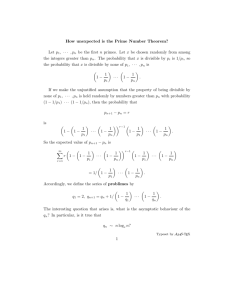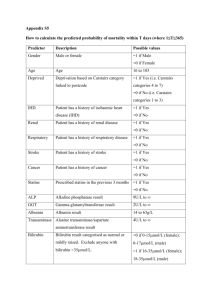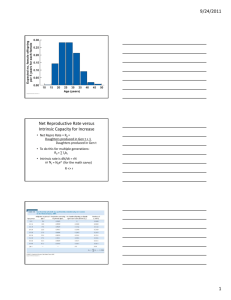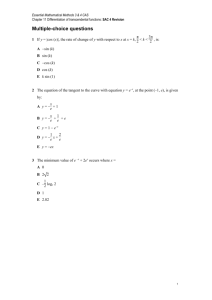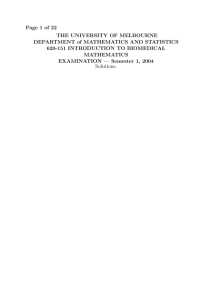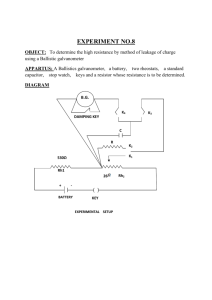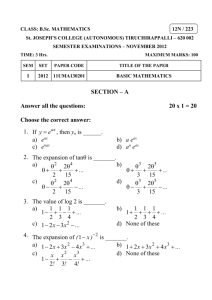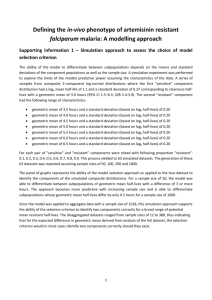Integrated Rate Equation method
advertisement
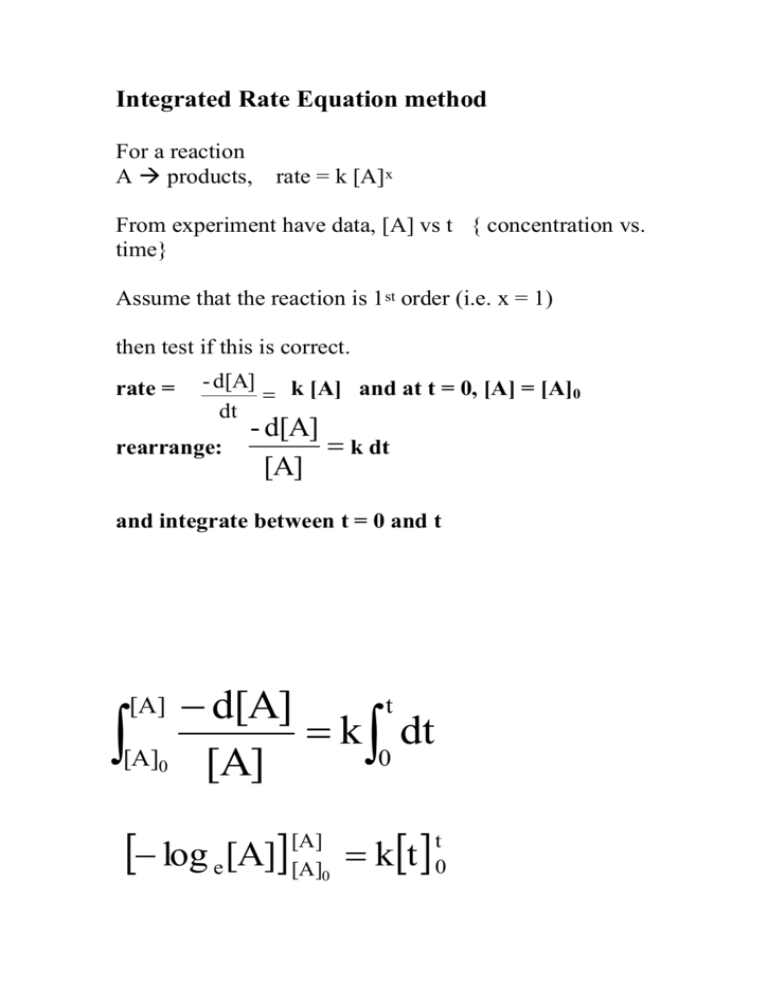
Integrated Rate Equation method
For a reaction
A products,
rate = k [A]x
From experiment have data, [A] vs t { concentration vs.
time}
Assume that the reaction is 1st order (i.e. x = 1)
then test if this is correct.
rate =
- d[A]
k [A] and at t = 0, [A] = [A]0
dt
rearrange:
- d[A]
k dt
[A]
and integrate between t = 0 and t
t
d[A]
[A]0 [A] k 0 dt
[A]
log e [A]
[A]
[A]0
kt
t
0
[A]0
kt
log e
[A]
If the reaction is 1st order then a plot of
loge([A]0 / [A]) vs t
should be a straight line with slope k
[A]0
log e
[A]
slope = k
t
But: - depends on the accuracy of the measurement of
[A]
- uses data throughout the experiment, ‘side
reactions’ may interfer
- have to assume that reaction is 1st order and test
assumption is
correct. If not then have to test a different rate
equation.
Note that this method does not require that the rate
is determined
at any time. Gets any from the problem of
estimating slope of the
[A] vs t graph.
Example:
At 600K azomethane decomposes as:
CH3N2CH3 (g) CH3CH3 (g) + N2 (g)
In a constant volume, the pressure of azomehtane varied
with time:
t/ s
p /102
mbar
0
1000 2000 3000 4000
8.20 5.72 3.99 2.78 1.94
Calculate the 1st order rate constant of the reaction
For a 1st order reaction: loge{[A]0 / [A]} vs t is a straight
line plot
And the slope is the rate constant.
How does pressure relate to concentration?
Gas Law: pV = nRT
Therefore p = (n/V)RT and (n/V) is the (number of
moles / volume)
which is concentration
Therefore at constant T and V, p is proportional to
[concentration].
Therefore, loge {[A]0 / [A]} = loge {p0 / p}.
In this example. p0 = 8.2 x102 mbar
p /102 mbar
p0 / p
loge{p0 / p}
t/ s
8.20
1
0
0
5.72
1.434
0.360
1000
loge{p0 / p} 0
t/ s
0
3.99
2.055
0.720
2000
2.78
2.095
1.081
3000
1.94
4.227
1.441
4000
0.360 0.720 1.081 1.441
1000 2000 3000 4000
loge{p0 /
p}
x
x
1
Slope = 3.60x10-2 s1
x
x
t/
s
200
0
400
0
Equation of the graph
loge{p0 / p} = 3.60x10-2 s-1 t
Rate law for the reaction
-d p(CH3N2CH3)/dt = (3.6x10-2) p(CH3N2CH3)
Example:
For the reaction, T = 400 K,
(CH3)2 O(g) CH4 (g) + H2 (g) + CO(g)
In a constant volume container, the total pressure varies
with time:
t/min
0.00 6.50 12.95 19.92 52.58
total
312 408 488 562 772
pressure/mbar
Calculate the 1st order rate constant.
Want to use loge{[p0 ((CH3)2 O(g) )/ p((CH3)2 O(g)) } vs t
but the data
is for the total pressure. How to change total pressure to
pressure
of reactant.
Use the stoichiometry of the reaction, and the fact that
pressure is proportional to the number of moles in
constant volume (concentration)
(CH3)2 O(g)
Initial
CH4 (g) +
H2 (g) +
CO(g)
0
0
0
x
x
p0
At time t
p0 – x
(x is change of pressure
of reactant)
x
Total pressure = sum of the pressures of components
= (p0 – x) + x + x + x = p0 + 2x
In the example, p0 = 312 mbar, therefore x can be
calculated at any time, and then
Calculate p(A) at any time:
( A = (CH3)2 O(g) )
t/min
0.00 6.50 12.95 19.92 52.58
total pressure/mbar 312 408 488 562 772
(p0 +2x)
=p0
x
p(A) = (p0 –x)
0
48
88
125 230
312 264 224 187 82
loge{p0(A) / p(A)} 0
0.167 0.331 0.512 1.336
Then plot loge{p0(A) / p(A)} vs. t , get straight line,
slope = 2.65x10-2 min-1 = k, rate constant
Half Life of a reaction, t1/2
For a unimolecular reaction (one reactant)
A products
The half life is the time for the initial concentration
of A to be halved
i.e. At t = 0, [A] = [A]0
at t = t1/2 [A] = [A]0 / 2
For a 1st order reaction:
loge { [A]0 / [A] } = k t
Therefore loge { [A]0 / ([A]/2) } = k t1/2
Therefore
s-1, hence t,s)
t1/2 = loge 2 / k
(Units, k,
For a 1st order reaction, the half-life does not
depend on
the concentration of the reactant.
e.g. The rate constant of a 1st order reaction is 1.386x10-2
s-1 .
How long for the reaction to be 99% complete?
How many half-lifes before less that 1% of reactant left?
100 – 50 – 25 – 12.5 – 6.25 – 3.125 – 1.5625 – 0.78125
Therefore 7 t1/2 needed.
t1/2 = loge2/ k = 50.0 s, therefore time needed for 99% is
350s
This is clearly an approximate method.
More accurate is to note that when the reaction is 99%
complete
[A] = 0.01[A]0 .
Therefore: loge {[A]0 / [A] } = loge{100} = k t
t = 3332.3 s (somewhat less
than 7t1/2)
Rate of reaction and temperature.
The rate constant is only changed by changing the
temperature
of the reaction.
Found experimentally that:
loge k α (-1 / T) – the larger the temperature T, the
larger k
Which leads to the Arrhenius Equation:
k = A exp (- EA / RT)
Where:
A is called the Frequency Factor
EA is called the Activation Energy
(and R is the Gas Constant, R = 4.183 J mol-1 K-1)
Remember – all chemical reactions are really
due to bimolecular collisions no matter how complex
they appear to be
from their stoichiometry.
A – the frequency of collisions between molecules,
collisions per sec
but only some of these have enough energy to result in a
reaction.
EA – the energy required to start a reaction. This energy
of the collision
of the molecules must be more than this value. The
energy is released
in the reaction and therefore can be reused to trigger
further reactions.
Consider the rearrangement reaction:
CH3NC CH3CN
The reactant molecules need to gain enough energy from
collisions
to distort their geometry to under go the reaction as
follows:
The CH3NC molecules gain energy through collisions
with
other CH3NC molecules and in some collisions enough
energy is gained to exceed EA and the reaction proceeds
to the product.
Example:
The 2nd order decompositon of ethanal was studied
giving the data:
T/K
700
730
760
k/
(mol L-1)-1s-1
0.011
0.035 0.105
790
810
0.343 0.789
840
910
2.17
20.1
Determine the activation energy and the frequency factor
k = A exp(-EA / RT)
loge k = logeA – (Ea / R) (1/T)
Therefore plot loge k against 1/T and get a straight line
Slope -(EA/R) intercept logeA
103/T
1.429
loge k -4.510
loge k
1.370
1.316
1.266
1.234
-3.352
-2.234
-1.070
-0.237 0.775
Select axes to fit data.
1.190
1.099
3.00
Slope of line = -2.207x104 K
3
103 /T (K-1)
0
1.1
1.5
-3
Slope = -2.207x10-4 = -Ea / R
EA = 2.207x10-4 (K) x 8.314 (J mol-1 K-1)
= 184 kJ mol-1
Cannot determine A by intercept at (1 / T) = 0 accurately
By substitution of EA value in theArrhenius equation of
each
point and then averaging the results, A 5x 1011 s-1
Frequency factors are usually of about this magnitude.
There are many collisions between molecules.
Example
The rate constant of a reaction doubles when the
temperature
is raised from 350C to 450C. Estimate the activation
energy of
the reaction.
k = k1 at T = 350C = 308 K
k = 2k1 at T = 450C = 318K
loge(k1) = logeA - (EA / R) (1 / 308)
loge(2k1) = logeA - (EA / R) (1 / 318)
loge(2k1) - loge(k1) = (EA / R) (1 / 308 - 1 / 318)
loge(2k1/k1 ) = loge 2 = (EA / R) (1.02x10-4)
EA = 56.5 kJ mol-1
